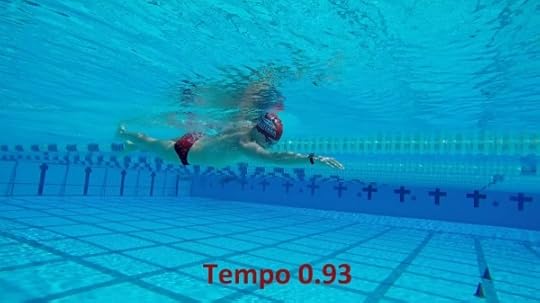Terry Laughlin's Blog, page 18
April 17, 2016
First Person: TI Pioneer Bill Holman at 85
It’s my happy privilege to publish this guest post from one of the earliest TI enthusiasts, Bill Holman, on the occasion of his 85th birthday. I met Bill in January 1993 at our first venture outside the US, a weeklong camp in Costa Rica. Bill’s familiarity with Spanish was most valuable to the rest of us anglos. I was delighted to hear from Bill recently and asked if he’d bring us up to date.
Happy Birthday, Bill!
I was a sickly child, all the common illnesses, plus rheumatic fever at age six, which left me with a life-long heart murmur. I was supposed to die from the effects of that disease at about age 40, as Bobby Darrin did.
I was kept on a close leash, prohibited from doing anything that might strain my heart. However, at about age 10, I managed to sneak away to a public park pool, and learn my version of swimming. I think I even kept my head sort of in the water.
Jump ahead about 10 years, I’m in college and take a swimming class. I found I enjoyed the peace and solitude of swimming. And no one asked why I was no good at baseball, basketball, etc.
Skip forward another 40 years, I have joined a YMCA,with a 25-meter lap pool. I swam a lot of laps for several years. One day a swimming friend said, “Bill, you’re a good swimmer, you should enter the Oregon State Games.”
I was 63 years old and had never before competed in anything. But I entered and won a medal, and was hooked on swimming.
I saw an ad for a Total Immersion swim camp in Costa Rica, and signed up. Terry , Alice their staff and all the students were wonderful to the old guy. By then I was in my 60s. I learned how to swim the TI way, liked how it felt, had a wonderful time, made new friends, and really improved my swimming.
I also improved my Spanish, since I was the only one of the group who spoke it.
Over the years I’ve continued improving my swimming and Spanish. I attended two more TI classes–in Portland and Seattle. I swam for many years in the State Games, qualified for Senior Olympics four times, swam in two international events, and was named Male Athlete of the Year for the State Games for the year 2000.
I’m now a permanent resident of Mexico, living in Puerto Escondido, in Oaxaca State. At 85, I still swim 36 laps every day.
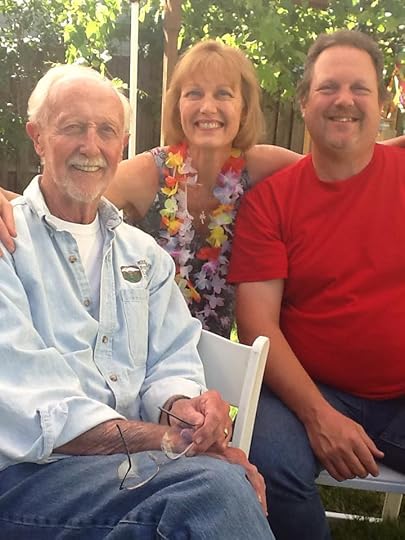
Bill Holman–looking fit from daily swimming–daughter Susanne, and son Michael
The post First Person: TI Pioneer Bill Holman at 85 appeared first on Total Immersion.
April 15, 2016
The 4 Stages of Skill-Learning. And the Critical Kaizen Loop
The Four Stages of Learning emerged from the field of psychology in the 1970s, and has since become widely familiar and accepted. It identifies four levels of competence one must experience in learning any new skill.
According to this model, we generally start out with a blind spot: “We don’t know what we don’t know.” We must recognize our deficit to progress further. Next we must consciously acquire the skill, then consciously use it. By doing so we gradually acquire the ability to use the skill somewhat automatically.
The four stages are called:
Unconscious Incompetence We fail to recognize that a higher skill level exists or that it has value. You may have escaped this stage quite early in your swimming experience. I didn’t do so for 25 years, until almost age 40. Until then, I believed my swimming potential was limited by a lack of ‘genetic’ traits. That notion was dramatically dispelled—in less than 10 minutes–when Bill Boomer taught me a balance drill, and I recognized I had a serious blind spot in my knowledge of technique. Even after coaching with great success for nearly 20 years!
Conscious Incompetence Like most TI swimmers, the first skill deficit I identified was balance. For 25 years, I’d thought I had ‘heavy’ legs and the only solution was to kick harder. When Boomer taught me to align my head and spine and shift weight forward, I was stunned at how my legs automatically—and effortlessly—lifted to the surface. That remains my single most transformative moment in 50 years of swimming.
Conscious Competence For the next six months I thought of almost nothing but maintaining a straight line between head and hips, and leaning on my chest (a technique called Press Your Buoy which we taught until the late ‘90s), fearful that—after 25 years of unbalanced swimming—I would lose this magical feeling if I wasn’t explicitly focused on it.
Unconscious Competence When I finally trusted that balance had become a moderately-durable habit, I immediately adopted a new skill goal—Swim ‘Taller,’ which I’d learned would reduce drag. This change was just as challenging: For 25 years I’d focused exclusively on pushing water back. Now I had to train myself to ignore the hand pushing back and focus on the one going forward.
This amounted to a change in pretty fundamental values system—that I should place a higher value on extending my bodyline, than on pushing water back. The fact that I felt markedly better convinced me. Swimming Taller kept me occupied for several more months—during which I regularly made time to check on head-spine alignment.
As soon as Swimming Taller began to feel consistent and more natural, I again chose a new skill focus—Holding My Place. After reaching forward, my focus would be to consciously hold my place with the lead hand—then spear the entering hand past it. This was a more complex and challenging skill that the first two I’d tackled. Fortunately I was prepared—in two ways.
If I hadn’t already learned balance, it would have been physically impossible to Hold My Place. As well, when I began to concentrate on aligning head and spine, it was my first experience in trying to hold a single ‘stroke thought’ for an extended period. That was surprisingly hard at first, but got easier over time.
When I tried to Hold My Place, I could feel my hand moving back. I had to learn to resolve the conflict between my intention and what I experienced. Fortunately I was prepared for this a far more demanding level of Conscious Competence, by nine months of prior conscious skill practice.
That occurred in 1989. In the 27 years since I’ve never lacked for a new skill goal to maintain in Conscious Competence. Which illustrates a critical distinction between the TI view of the learning stages, from that commonly taught.
The Kaizen Continual Loop
It is not a stairstep progression from Unconscious Incompetence, ending in Unconscious Competence, as shown in this illustration.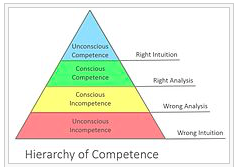
Rather one’s goal should be to maintain a continual loop. Upon moving from Conscious to Unconscious Competence in one skill; immediately identify a logical next step. Recognize your Conscious Incompetence at a related, slightly more challenging, skill and bring it into Conscious Competence, then work consciously on it until it happens more autonomously. Then start the process all over again, as illustrated here.
Here’s one more thing. This process actually involves a change in the physical location in the brain where we process cognitive and motor skill. During the Conscious Competence stage, we process in the Cerebral Cortex, an area with especially dense neural connections. The Cerebral Cortex consumes a lot of energy. The same energy—oxygen and glycogen—used by the muscles.
When we achieve Unconscious Competence that activity is run by the Cerebellum, which uses far less energy. Each time we learn a new skill this way we not only increase our mechanical efficiency, we also increase our energy efficiency in a surprising way.
The post The 4 Stages of Skill-Learning. And the Critical Kaizen Loop appeared first on Total Immersion.
April 8, 2016
Video: How TI Coach (and Columbia University Dean) Darbi Roberts rocked a 9:05 at Ironman Arizona–a PR by 20 minutes!
2015 was a banner year for TI coaches who compete in triathlon. Coach Kirsten Sass became the most decorated age group multisport athlete in history, achieving an unprecedented sweep of Triathlete of the Year and Duathlete of the Year honors from Triathlete magazine. (Watch for an interview with Kirsten next week.) And, in November, Coach Darbi Roberts smashed her Ironman PR by an incredible 20 minutes to record a 9:05 at Ironman Arizona.
For any athlete competing at the Iron distance, a 20-minute improvement would be quite satisfying. But for a woman whose previous PR was 9:24–already elite level–a 20-minute improvement is quite stunning. This accomplishment is made even more impressive in the context of the incredibly full life Darbi leads.
A Paragon of Life Balance
Though Darbi races triathlon as a pro, being a triathlete isn’t her occupation. From 9 to 5, Monday through Friday, Darbi is Dean Roberts at Columbia University, where she oversees student affairs at Columbia’s School of International and Public Affairs. And this spring she’ll add Dr. Roberts to her titles when she completes a doctorate in education at Columbia’s renowned Teacher’s College. And Darbi has also found time to publish numerous papers in academic and educational journals.
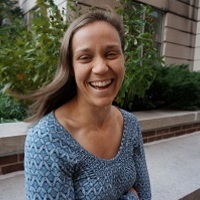
Dean Roberts at Columbia University
In February I had the pleasure of coaching alongside Darbi at the TI Triathlon-Swim Camp at the National Triathlon Training Center in Clermont FL. I took the opportunity to record a conversation on how she manages to balance such rarefied athletic feats with professional and personal attainments that few, if any, other pro athletes would attempt. Darbi explains how Total Immersion has allowed her to realize her full athletic and competitive potential while doing so.
Racing Strategically
One invaluable insight Darbi shares in the interview is that the key to her 20 minute improvement was swimming easily during her IM race. Even while minimizing effort, her swim split of 51:09 beat her personal PR by over a minute, a testament to the efficiency she has gained through TI practice. And her reward for swimming smart-not-hard was to cap her Ironman with a stunning 3:12 marathon, 20 minutes faster than she’d ever run before.
Swimming better through smarter choices–not greater efforts–is of course a touchstone of the Total Immersion method and is the most strategically sound way to swim in triathlon. Darbi, who was an age group swimmer and rowed in college at Carnegie Mellon, could have swum harder, but made a strategic choice that an easy swim would result in the best overall race. I explain why this so advantageous in the ebook Sneaky Speed: Smarter Choices in Triathlon Swimming. To learn more download a free copy from our online store.
And to learn to swim in triathlon as Darbi did, join us at our next Triathlon Swim Camp May 11 to 13 in Key Biscayne FL.
Stay with the interview to the end to see Darbi join me for a synch-swim and demonstration of TI technique in the NTC pool.
The post Video: How TI Coach (and Columbia University Dean) Darbi Roberts rocked a 9:05 at Ironman Arizona–a PR by 20 minutes! appeared first on Total Immersion.
March 31, 2016
Watch Ryan Lochte teach swimming! Would you teach differently?
According to his web site Ryan Lochte is ‘considered by many to be the best swimmer in the world.’ If Michael Phelps hadn’t come out of retirement, that might well be true . . . though fans of Katie Ledecky might beg to differ.
Still his achievements–11 Olympic medals and World Records on four occasions– are truly impressive.But how well does elite level swimming experience translate into teaching someone else. Particularly when that someone is your typical adult swimmer.
Watch this video of Lochte teaching USA Today reporter Nicole Auerbach. Then I invite you to ‘play TI Coach.’
Based on your own experience learning and practicing TI, and what worked well for you, would you have done anything different if asked to teach Nicole?
In the comments section here, or on the TI Facebook Group, I invite you to Be The Coach and outline a simple lesson–5 to 10 minutes or less–that would allow Nicole to take away something valuable, in skill and understanding of what matters. Choose any stroke; Ryan gave her a lesson in all four.
The post Watch Ryan Lochte teach swimming! Would you teach differently? appeared first on Total Immersion.
March 25, 2016
What I Wish on my 65th Birthday
Today is my 65th birthday. Werner and Birgit Goldbaum of Germany made this cake in my honor and sent it, saying they were ‘pressing our thumbs to your heart.’ A German expression for warmest wishes.

Werner and Birgit’s Cake
Seeing the cake was nearly as delicious as tasting it would have been. Happily, their message was the first of the day
I’m writing today to share my own birthday wish, or intention. But first I must rewind exactly three months.
Christmas morning I received an email from a TI student named Kirill, originally from Ukraine, currently living in Belgium. Our first exchange was pretty routine. He requested advice about ordering our downloadable Complete Self-Coaching Toolkit. I encouraged him.
Kirill sent regular progress reports. At first they were technical, but before long his writing began to suggest an especially strong personal connection with TI. I expressed my appreciation and encouraged him to practicing in that spirit.
Within a month he revealed he’d begun thinking about becoming a TI coach and included a link to video, asking if I felt he might qualify. That video showed that he’d already become a strikingly graceful swimmer.
I connected Kirill with TI Coach Marjon Huibers in Amsterdam. Not only because she was close by, even more because she’d shown herself to be a great mentor and exemplar for aspiring TI Coaches. Kirill took a workshop with her in Amsterdam. Besides his first formal coaching, Kirill also received Marjon’s enthusiastic recommendation for proceeding to coach training..
After attending a 10-day vipassana meditation retreat, Kirill said he wanted to share some connections he’d made between his meditation and TI. We agreed on a Skype chat, which happened just a week ago.
We spoke relatively little about meditation or the retreat. But Kirill said something that impacted me as much as anything I’ve heard said about TI. Describing his motivation for becoming a coach, he said “I believe Total Immersion can make the world a happier place. I want to be part of that.”
I overflow with happiness while practicing—and for hours after. That feeling has grown stronger year by year; in the past few months, it’s become my #1 practice goal. (Watch for a post soon in which I describe the reasons and ways that happens.)
Even so, Kirill gave voice to words I’d never actually spoken or written, which provided a sense of meaning and purpose greater than any I could have expressed myself.
So here is my birthday intention: During my 66th year I will consciously strive to make the world a happier place. Using the means most available to me.
I will start with those nearest and dearest, then expand the circle to all who are teaching, learning and practicing TI, and finally to those who should be. (i.e. Everyone.)
If you are reading this, I invite you—either in a comment here or on our Facebook group–to complete this sentence:
TI makes me happy by . . .
The post What I Wish on my 65th Birthday appeared first on Total Immersion.
March 17, 2016
1390 Seconds of Unwavering Focus
In the final paragraph of last week’s post The Defining Event of My Life, I mentioned that I would swim the 1650y freestyle in the New England Championships the next day. It would be my final race in the 60-64 age group.
How did it go? Better than I imagined possible: I broke the Adirondack Masters 60-64 record for the event. Based on my training and my most recent race (13:56 for 1000y on Jan. 23, which I mentioned in my last post) I estimated I could maintain a pace of 1:25 per 100 yards if I swam well. That pace would project to a time of 23:45. Since it had been 10 years since I’d swum the event, I put that down as my entry time.
But I also had my eye on the Adirondack record of 23:20: If I swam a near-perfect race, I felt I could approach it. The challenge of trying to achieve that–the perfect race, not the time–had me really excited about the race.
When I hit the touch pad and saw 23:10 displayed for my lane, I had to look twice to be sure that was really my time. But disbelief quickly gave way to elation.
Again–not because of my time. In fact, during the entire race, I hadn’t given a single thought to my time or the possibility of a record.
All I thought about was the many elements of technique and pacing I needed to execute at the highest possible level in order to swim a perfect race. From the time the starting horn sounded, my attention was occupied by an unbroken stream of consciousness about how I was swimming.
When I struck the touchpad at the finish, I knew I’d maintained absolutely unwavering focus for every one of those 1390 seconds. Though it was my slowest time ever for 1650, it was unquestionably the best race—and probably the best swim–of my life.
I felt as if I was working at my utmost capacity—body, mind, and spirit—every moment. And I’m even willing to assert that I believe my capacity for focus in a challenging situation is every bit as good as—no, make that better than—any swimmer on earth . . . even Katie Ledecky or Sun Yang.
Having Stage 4 prostate cancer undoubtedly means that my strength and endurance have declined. And for several weeks prior to the start of treatment (Feb 11) I had energy enough only to swim quite gently—yet perfectly—for 30 minutes or less, about three times per week.
On the other side of the equation is the highly intensive meditation and visualization I’ve practiced even while physically weakened. These have noticeably increased my mental strength and emotional stability. And for my ability to raise my mental game, I have years of mindful, purposeful TI practice to thank. It has been an invaluable foundation for what I must to do to prevail against cancer. Experiencing the best swim of my life last Saturday was the natural culmination of both streams of experience.
I’ve begun preparing for Masters Nationals, where I’ll make my debut in the 65-69 age group, with great anticipation. I’m thrilled by how well my practices are going—and that I experience Flow in every one of them. I invite you to follow my preparation; I log every practice here.
May your laps be as happy as mine.
Terry
The post 1390 Seconds of Unwavering Focus appeared first on Total Immersion.
March 11, 2016
The Defining Event of My Life
Dear Friends
In the past 10 years I’ve written many times on “Injury as Opportunity.” This resulted from experiences where injury or illness required me to slow down in many ways. My belief in the healing powers of water and swimming, has motivated me—whenever possible—to use swimming to aid in healing. Swimming to heal–rather than train–promotes much deeper self-examination and self-awareness.
This first occurred in 2004. I’d detached the biceps tendon in my right shoulder while lifting weights. (Careful form, slow movement, moderate weight . . . but a middle-aged shoulder.) Formerly routine actions–donning a seat belt, pouring tea, flicking a light switch on the wall–were too painful to perform with my right arm.
Yet I continued swimming. My health insurer required five months of therapy before surgery, and I expected to regain strength and function more quickly afterward by remaining active. I experimented with several stroke modifications, seeking a way to swim with minimal pain.
Before long—so long as I mindfully avoided certain long-time habits–I was actually swimming pain-free. By the time of surgery I was even swimming slightly faster than before–despite being unable to pour tea without searing pain!
I’ve swum ever since with those techniques. You know them today as Rag Doll Recovery, Mail Slot Entry, and Patient Catch. [Read the full account in the blog post How to Swim Faster and Pain-Free.]
Something similar has occurred since my prostate cancer diagnosis, which I mentioned briefly in the post Opportunity in Adversity, last December. At that time, the plan was to remove the prostrate . . . after which, I anticipated I’d return to care-free, cancer-free, living.
However, pre-surgical tests suggested that the cancer had spread to my bones. Though this would only be confirmed in early February by a bone biopsy, I knew ‘in my bones’ that it was true and the news threw me into a state of doubt, fear, and dread that lasted several days.
The one startlingly bright spot in that dark period came on Jan 23 when I went to a Masters meet and swam three events—200, 500, and 1000 Free. I’d entered the meet planning to make it my last hurrah to six weeks of no swimming during recovery from surgery, which had been scheduled for Jan. 25. Though I was feeling ill that morning, I went to the meet anyway.
The Meet of my Life
I felt transformed once I was on the pool deck. I was in a somewhat weakened state and had been swimming pretty slowly in practice. I knew I had to swim with the best technique, mindset, and pacing I could muster in order to meet this challenge.
Though my times in the 200 (2:35) and 1000 (13:56) were my slowest ever, and the 500 (6:48) my second-slowest, in every way that mattered, it was the best meet I’d swum in 50 years.
I felt happy and engaged throughout several hours at the pool. I enjoyed time with long-time friends—and made a few new ones. And I swam absolutely lights-out. The high from that experience lasted through bedtime that night.
That showed how critical swimming . . . and being an athlete in training for challenging and meaningful goals . . . would be to recovery.
Taking Charge
The news that my case was more complicated also galvanized me take personal responsibility for my recovery. I began to study the book Radical Remission by Dr. Kelly Turner, a gift from Jonathan Amoia, formerly a coach on a Masters team on which I’d swum in the early ‘00s, now a financial planner. Jonathan’s gift is characteristic of the many thoughtful acts from people who learned of my situation.
The book described many instances in which people who’d been deemed incurable brought about spontaneous remission of their cancer, and the curative factors they had in common. These were diet, exercise, avoidance of stress, strengthening the immune system and bringing one’s mental, emotional, and spiritual capabilities to full bloom. In posts to follow I’ll describe how I’ve pursued this program.
While my situation, thankfully, isn’t nearly as threatening as many of those described in the book, the Radical Remission philosophy was exactly what I needed at the time. I’d known for two months that I had cancer, yet had felt helpless waiting through tests and many delays. It’s known that cancer cells reproduce at an extreme rate and I was deeply anxious for treatment to commence.
The book showed me that—even while still trusting in the powers of medical intervention—there were many supplementary alternative healing approaches I could employ myself. Most important I would feel that I was taking control of my own recovery.
Doctors often say there is no ‘silver bullet’ in cancer treatment. I’ve come to disagree. If there is one it’s the power one gains by acting as agent of your own recovery. It gives you the mental and spiritual strength it takes to convert dis-eased cells back into healthy ones.
Two ‘arrows in my quiver’ were:
Fifteen years of mindful swimming practice, a jump start toward essential psychic strengths.
A Kaizen mindset, which has led to every stroke feeling well-nigh blissful.
Zero-Cancer Swimming
Shortly after I learned I had bone mets I joined the organization ZeroCancer for those with prostate cancer and their supporters. This provided the inspiration for “Zero-Cancer Swimming,” which means two things:
As I swim, I feel vibrant health and strength in body, mind, and spirit. I do emphatically feel cancer free.
Employing visualization and affirmation to return cancer cells to their natural healthy state is essential to Radical Remission. I practice at every opportunity, but it feels most genuine and powerful as I swim. My practice is itself an affirmation which states: “My body is strong and healthy and has the resources to heal itself.” I believe every mindful stroke is ‘zero-ing out’ cancer cells.
In the past two months I’ve sensed profound beneficial change in habit, clarity, and mindset that I attribute directly to this experience and which I know will endure beyond my journey to healing.
“The Defining Event of my Life”
Several weeks ago, I received an email from TI Coach Celeste St. Pierre. Though her email was to several TI coaches, one part spoke to me with uncanny directness, a moving story about James Stockdale from Brian Johnson’s “The Optimizer” newsletter. (optimizer@brianjohnson.me if you’re interested in subscribing.)
In 1965, Stockdale, a U.S. Navy pilot (later an admiral; he ran for Vice President on Ross Perot’s Independent ticket in the 1992 presidential election) was shot down and spent six years as a prisoner of war in Vietnam.
Stockdale had just 30 seconds after his plane was disabled before landing, and what he knew would be a long and brutal confinement. In his final seconds of freedom, he had the presence of mind to reflect on some Stoic philosophy from Epictetus. He summarized his thoughts in this quote from his book Courage Under Fire.
“I never lost faith in the end of the story. I never doubted that I would prevail in the end and turn the experience into the defining event of my life, which, in retrospect, I would not trade.”
In far more eloquent terms than I had, he crystallized thoughts I’d developed gradually over the prior two months.
This weekend, at the New England Masters Championship at Harvard, I will swim the 1650-yard freestyle (1500m equivalent) my first mile race in the pool in 10 years. Though I expect it will be my slowest 1650 ever, I’m anticipating it more than any other race I’ve swum in 50 years. Next week I’ll let you know how it went.
May your laps be as happy as mine,
Terry
Follow every lap of my practice here.
Join me at my next workshop, March 16 in New Windsor NY.
Or when I coach at our Triathlon Swim Camp April 7-11 in Clermont FL
The post The Defining Event of My Life appeared first on Total Immersion.
March 5, 2016
New Stroke Demo Videos
I was in Clermont, Florida last week to attend a joint ‘Fast Forward’ TI Coach 2.0 training camp led by my colleague Tracey Baumann and Erin Glynn and a TI Triathlon Training Camp led by coaches Celeste Saint Pierre, Suzanne Atkinson and Dinah Damian. Head Coach Terry was there and floating between the two.
I had the chance to get some new stroke demo videos made in superb water conditions.
In this first video I am using a Tempo Trainer set to 0.93 in order to see what my stroke is doing now that I’ve been working in the .90s these last few weeks for my 100y Sprint Improvement Project.
~ ~ ~
To read more of this article – New Stroke Demo Videos – visit Coach Mat’s Smooth Strokes Blog.
PS – There is a bonus video of Coach Terry and me sync swimming!
The post New Stroke Demo Videos appeared first on Total Immersion.
March 4, 2016
A Legend Relearns Swimming–helped by a 95 y.o. Coach!
On Feb 15, the article A Swimming Hero Relearns How to Swim appeared in the Wall Street Journal. It featured Marilyn Bell DiLascio and Paul Lurie–78 and 98 ‘years young’ (this phrase fits them if it fits anyone, as you will see) respectively. I was also privileged to appear in the article with them. The article has uplifted and inspired all who read it. Leave a comment at WSJ if you feel the same.
I’ve known Marilyn for two years and Paul for four. In the article, Kevin Helliker, the WSJ reporter, provided details of which even I was unaware. In this post I’ll share aspect of their story which help explain why the Wall Street Journal became interested in them.
Last August 25 at 7:30 AM, I received an email from Marilyn which contained no text, only this image of her phone.
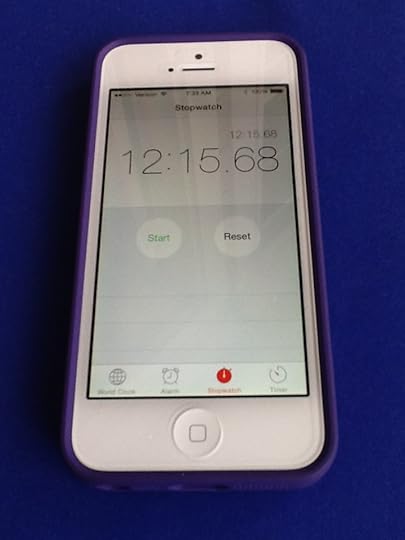
Marilyn’s Phone: Paul’s latest record
I knew instantly what it meant: That morning Paul–just two months shy of his 98th birthday—had set another personal record for 20 lengths of the pool at Woodland Ponds, the senior residence where both live.
The world’s first 90+ Kaizen swimmer!
I gave Paul the first swim lesson of his life when he was 94. By that time–guided only by a TI self-coaching video–he’d already developed an impressively balanced and relaxed freestyle. Over the next few months, I taught him additional freestyle skills plus a relaxed, balanced backstroke.
Each morning at 6:45, Paul swam a 20-length standard practice in the 50-foot Woodland Pond pool. He alternated two lengths of freestyle with one of backstroke. To measure progress, he occasionally timed himself.
Like many nonagenarians, Paul suffers from atrial fibrillation; even mild exertion causes his heart to race. As a retired cardiologist, he knew that could be quite dangerous, so he waited patiently for his heart to return to a safe rate after each length.
Those long recovery periods occupied enough time that it initially took Paul 22 minutes to complete just over 300 meters of swimming. But he continued working patiently on improving efficiency. Every few weeks, when I swam with him, I could sense he was a little bit faster . . . and more relaxed.
As he gained efficiency, he need less recovery between laps. His 20-length time improved from 22 to 20, 18, and finally 16 minutes. One morning, he dipped below 16. He doubted he’d have swum that fast. The next morning, he asked Marilyn (she’d begun practicing TI and become Paul’s regular swim partner) to count his laps and time him. The stopwatch on Marilyn’s phone read 15:46 at the end of his swim.
A few days later, Paul said to both of us, “I think I should retire the record. It’s probably not healthy for a 96-year old to be pushing himself to swim faster.” But the thing is, Paul wasn’t pushing himself. His times improved as he learned to maintain greater ease.
A measure of that is that he asked me to teach him how to turn properly because “I feel relaxed enough now to swim two lengths before taking a rest.”
Several months later, Marilyn informed me that Paul’s record had dropped to 14:06. He’d kept his promise not to try to swim faster. It was just the opposite: As he gained in ease and control, he couldn’t help completing his laps faster. Speed ‘happened.’
Which brings us to last August 25 and Paul’s latest record.
A Man with a Plan
A short while after receiving Marilyn’s message, announcing Paul’s new record of 12:15, I received an email from Paul. It said:
“This morning I had a feeling I could record a new best time. So I went to the pool with a plan. During every stroke I just kept reminding myself ‘Rag Doll, Rag Doll, Rag Doll’.” (This TI focal point refers to an intention to turn off every muscle below the elbow, so forearm and hand hang from the elbow like a rag doll during recovery.)
I’d learned not to be surprised by anything Paul did, but I doubted that ever before in the history of endurance sport had a nearly-98 year old gone to the pool with an intention—and a plan–to break a personal record. I forwarded these messages to Kevin Helliker, who had interviewed me several times for articles on swimming.
I asked Kevin if he thought it was newsworthy, not only that someone Paul’s age was still able to conceive of setting new personal swimming records, but that he’d formulated a strategy for doing so. And finally that that strategy was completely counter-intuitive. (Swim faster by relaxing more?)
Kevin agreed and thus the article got underway.
The Back Story
I’d like to share two more details of the saga of Paul and Marilyn which I find exciting. The first is how quickly they felt empowered and confident to coach each other. The second is how my experiences teaching them have influenced the latest refinement of the TI learning method.
Empowered to Coach
As I wrote above, using our self-coaching tools, Paul had already learned a freestyle of rare efficiency over the course of a few months before I met him. During the months I spent with both of them, I gave each only a few cumulative hours of instruction.
To avoid taxing Paul’s stamina, I limited lessons to about 30 minutes. Then he’d practice daily on his own for about two weeks before our next lesson. So Paul’s ratio of self-coaching to me coaching him was about 12 to 1 during that period.
Two years later, when I began coaching Marilyn, she needed even less instruction—just three to four hours total. Partly because she was such an experienced swimmer. But also because between my bi-weekly visits, Paul was coaching her. Or rather, they were coaching each other.
Using Marilyn’s ipad they regularly shot video of each other’s strokes, comparing her form with his and looking for kaizen opportunities in both. The speed with which they felt fully empowered to coach each other—and the demonstrated effectiveness with which they did it—is thrilling to me.
A Streamlined Learning Sequence
In 2012, I’d offered to teach Paul gratis because it seemed like an invaluable opportunity to learn, as Kevin Helliker put it, “how old is too old to improve at swimming.” My oldest student to that point had been 83.
I discovered that several drills we’d used for over 10 years (SpearSwitch and SwingSwitch and variations) were too difficult and tiring for Paul. They were fairly complicated and required more strength than he possessed.
I found I could teach the same skills by two means: (1) Using drills with fewer ‘moving parts’–Torpedo, Superman, and Skate, but adding a few new Focal Points for each; and (2) Practicing finer skills—mainly recovery movements–in a standing position, allowing Paul to be comfortable while I assisted him in ‘rehearsing’ mini-skills before he tried to do them while swimming. He was able to quickly absorb the new movements and integrate them into his stroke.
Since this simplified approach had worked so well, I used it again with Marilyn. And seeing how quickly both developed beautiful form, I thought “why shouldn’t everyone learn this way?”
Today, if you attend a TI Effortless Endurance Workshop or teach yourself with our Complete Self Coaching Toolkit, and find the learning sequence easier to master, give some of the credit to Paul and Marilyn
See Paul and me swimming in synch at Woodland Pond. Can you tell which swimmer is 62 and which 95?
See video of Marilyn and me synch-swimming in Lake Minnewaska . . . her first open water swim in 32 years and almost 60 years to the day from her historic crossing of Lake Ontario.
Read my previous post on Marilyn and Paul. Marilyn Gets Her Mojo Back.
The post A Legend Relearns Swimming–helped by a 95 y.o. Coach! appeared first on Total Immersion.
December 31, 2015
Guest Post: The 3-Day Makeover–From 100 Meters to a Mile
This guest post was contributed by Sampath P.B. from Hyderabad India who first emailed me in early December. I saw remarkable similarities between Sampath’s story and Amir Khan’s guest post From Swimming Nightmare to Swimming Dream which I’d published just days before.
Both are ‘pioneers’ in places where TI is little known. Both were absolute beginners who dreamed of swimming in open water. Both had stalled at ‘Terminal Mediocrity’ in lessons with a traditional coach. Both transformed themselves practically overnight with TI self-coaching tools. Both then taught TI to their sons.
But Sampath did something even more remarkable: In his first three days of TI practice, he progressed from 100 meters to a mile. Naturally, I invited him to share his story with you. Enjoy!
Happy Laps, Terry
* * *
Sampath’s Story
I began going to the pool regularly in Nov. 2014. I was 40 years old and an absolute beginner at swimming–and at sports. I signed up with a coach and eagerly began instruction. I set a goal of swimming 500 meters after four months and a full kilometer within a year.
My coach was well-meaning, teaching what he knew. He had me pull with buoys and kick with boards. And of course swim lap after lap. But after five months, even my intermediate goal of 500 meters was still hopelessly beyond my grasp.
Despite 100% attendance at his classes, I could swim no farther than 100 meters. The last 25 meters I felt almost desperate to reach the wall. I asked the coach how I could swim farther. He said I was doing reasonably well for my age–but I must work harder.
I began to search for answers on-line. Most of what I found was about how to pull and kick. Then I came across an 8-part series called Work Less Swim Better in which Terry Laughlin explained how to swim better for long distances and in open water. This was my dream. 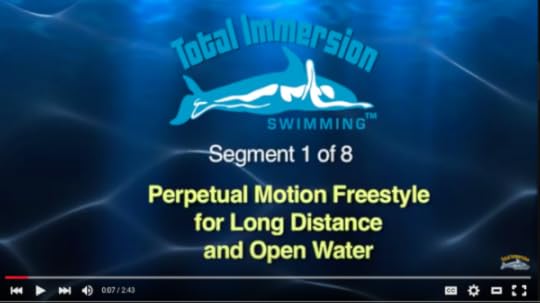
Terry’s advice was very different from what I’d been hearing. I wanted to try the arm recovery and entry he demonstrated in Part 7. But it was the opposite of what my coach wanted me to do, and I feared upsetting my ongoing training. 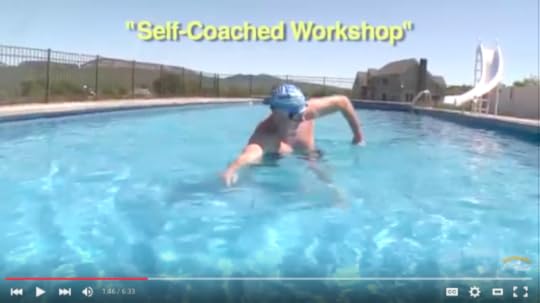
Soon after, my coach was transferred to another pool. The new coach showed no interest in training newbies. At this time, I came across a fellow swimmer who seemed to have ‘cracked the code.’ Though he is physically challenged, he’d swum 6K in open water after only six months of practice. How had he progressed so far?
I asked his secret. He said “Total Immersion.” This became my impetus to apply what I’d seen on TI videos. The next day–after focusing on streamline, and the Mail Slot entry–I felt completely fresh after my first 100 meters.
After a moment’s surprise, I pushed off again and swam another 100 meters. I still felt fresh. So I carried on and swam 800 meters nonstop—eight times farther than I’d been able to swim just a day earlier.
The next day, I swam 1200 Meters straight. The third day, I swam 1600 meters—60 percent beyond what had seemed an impossible goal only a few days before. The only reason I stopped at 1600 meters was because my time was up. When I got home from the pool, I ordered the TI Self-Coaching Toolkit.
I’ve studied and practiced each mini-skill on the videos many times. I’ve made much progress but know I can improve much more. As a Kaizen swimmer. I’ll continue working toward the dream of perfection in my daily practice of 1.5 to 2Km. For instance, Mat Hudson’s analysis of the 2-Beat Kick helped greatly in improving my 2BK. Thank you Mat!!!
I’ve also started to teach TI to my 10-year old son, Ramanan. He used to find swimming exhausting and tedious; when it was time to go to the pool for classes, he always had an excuse not to go. He became converted in only one session learning TI. Now he’s progressing quickly and is excited about swimming.
My peak experience so far occurred on Nov 28, when I completed a 5K sea swim in the “Swimathon,” at Colvai Beach, Goa, India. My goal was just to enjoy every stroke and feel fresh the whole way. 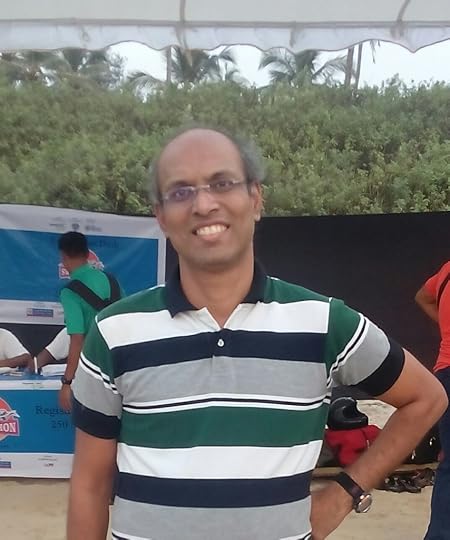
I swam as if repeating a mantra: BALANCE . . . BALANCE . . . BALANCE. I achieved this by focusing on releasing my head to the water and entering my hand through the Mail Slot. Each time my form didn’t feel right, I rechecked those and immediately felt form and ease return.
Maintaining this focus also helped me feel perfectly comfortable throughout two loops around a 2.5K triangle in the sea. Completing this goal showed me the truth of one of the famous sayings of Swami Vivekananda: “ All power is within you . . . you can do anything and everything . . . Faith, Faith, Faith in oneself is the secret to success.”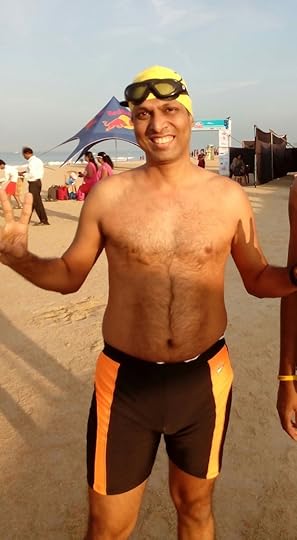
I’ve also seen that TI learning and practice principles can be applied universally. Not just other sports, but to one’s profession and even to human relationships. I look forward to writing another post about how I apply TI in other areas.
About Sampath: I’m an Engineering Manager in the Indian division of a US Integrated Circuit company. My interests include study of philosophical works (Bhagavad Gita, Complete works of Swami Vivekananda). I learnt yoga from a master a long time ago, but only began regular practice recently. I practice yoga for 30 minutes in the morning, before my swim. My other interest is painting. Like swimming, I began painting as an absolute beginner and am improving with practice.
Swim Better Than You Ever Imagined Possible.
Do you have a swimming dream? Would you love to swim better, easier . . . faster? Would you love to swim a tireless mile? Or 5K (half marathon) or 10K (full marathon) or more in open water? Or maybe help family or friends swim with ease and enjoyment?
Swim better than you ever imagined possible, and become your Own Best Coach.
Download our Complete Self-Coaching Toolkit today and start your transformation tomorrow. 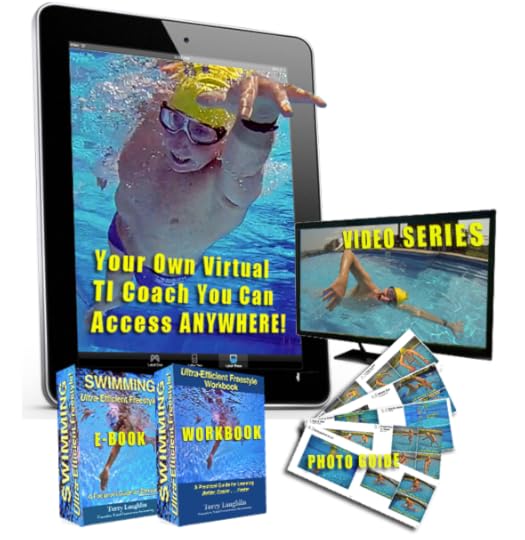
The post Guest Post: The 3-Day Makeover–From 100 Meters to a Mile appeared first on Total Immersion.
Terry Laughlin's Blog
- Terry Laughlin's profile
- 17 followers


